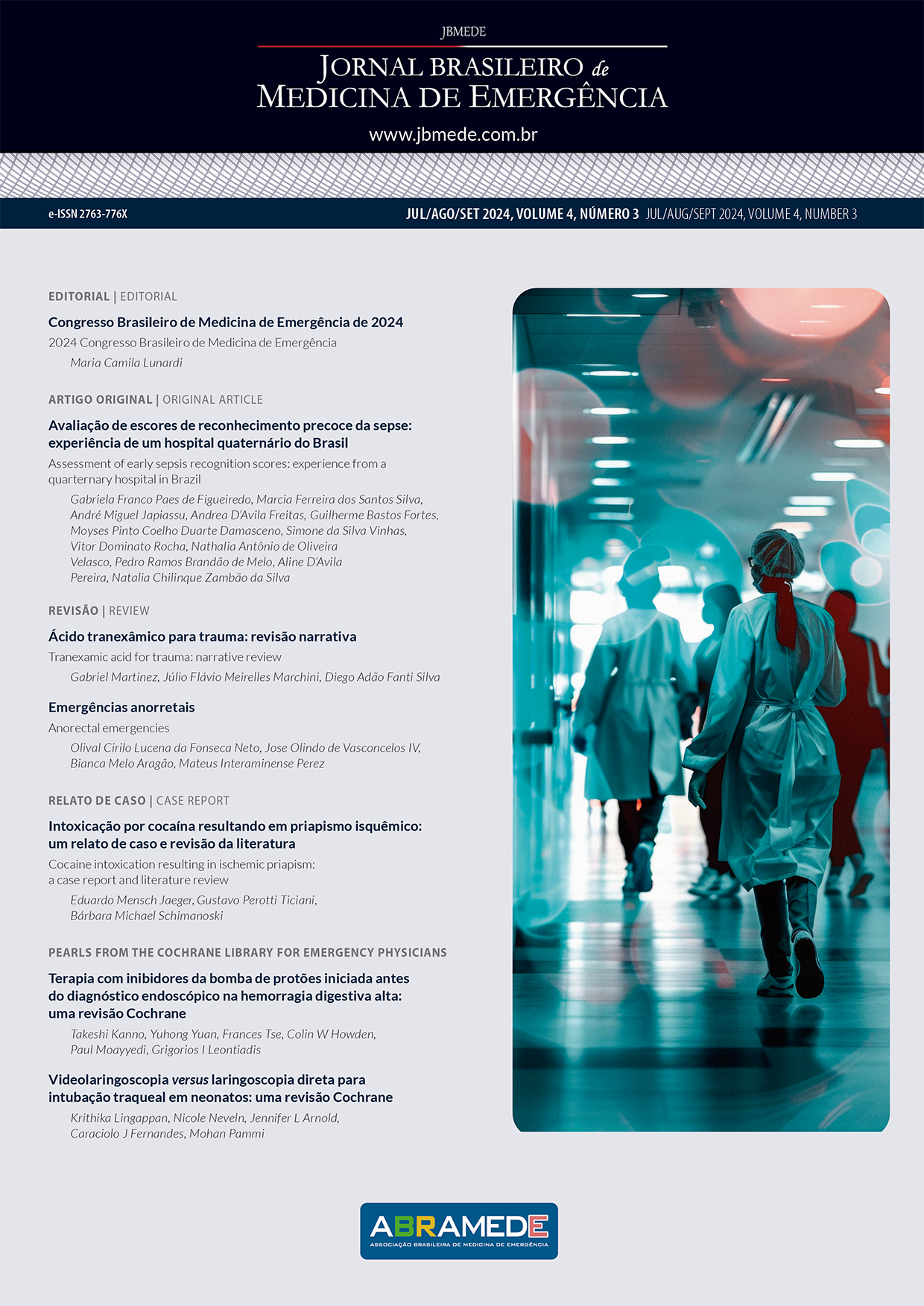Tranexamic acid for trauma: narrative review
Main Article Content
Abstract
Trauma is one of the main causes of death and disability worldwide. One of the main treatments for this situation is the infusion of tranexamic acid in patients with trauma-induced coagulopathy or even traumatic brain injury. We discuss the evidence on the use of this drug in trauma patients with the conditions described. Thus, this narrative review aimed to point out the results, divergences and new perspectives of the main studies and new recommendations related to tranexamic acid infusion in patients with trauma-induced coagulopathy and traumatic brain injury.
Article Details

This work is licensed under a Creative Commons Attribution 4.0 International License.
References
GBD 2017 Causes of Death Collaborators. Global, regional,
and national age-sex-specific mortality for 282 causes of death
in 195 countries and territories, 1980-2017: a systematic
analysis for the Global Burden of Disease Study 2017.
Lancet. 2018;392(10159):1736-88. Erratum in: Lancet.
;393(10190):e44. Erratum in: Lancet. 2018;392(10160):2170.
GBD 2019 Diseases and Injuries Collaborators. Global burden of
diseases and injuries in 204 countries and territories, 1990-
: a systematic analysis for the Global Burden of Disease
Study 2019. Lancet. 2020;396(10258):1204-22. Erratum in:
Lancet. 2020;396(10262):1562.
GBD 2016 Traumatic Brain Injury and Spinal Cord Injury
Collaborators. Global, regional, and national burden of traumatic brain injury and spinal cord injury, 1990-2016: a systematic
analysis for the Global Burden of Disease Study 2016. Lancet
Neurol. 2019;18(1):56-87. Erratum in: Lancet Neurol.
;20(12):e7.
Hanley C, Callum J, Jerath A. Tranexamic acid and trauma
coagulopathy: where are we now? Br J Anaesth. 2021;126(1):12-
Nascimento Júnior B, Scarpelini S, Rizoli S. Coagulopatia no
trauma. Medicina (Ribeirão Preto). 2007;40(4):509-17.
Dewan MC, Rattani A, Gupta S, Baticulon RE, Hung YC, Punchak
M, et al. Estimating the global incidence of traumatic brain injury. J
Neurosurg. 2018;130(4):1080-97.
Rossaint R, Afshari A, Bouillon B, Cerny V, Cimpoesu D, Curry N,
et al. The European guideline on management of major bleeding
and coagulopathy following trauma: sixth edition. Crit Care.
;27(1):80.
Hijazi N, Abu Fanne R, Abramovitch R, Yarovoi S, Higazi M, Abdeen
S, et al. Endogenous plasminogen activators mediate progressive
intracerebral hemorrhage after traumatic brain injury in mice.
Blood. 2015;125(16):2558-67.
CRASH-2 trial collaborators; Shakur H, Roberts I, Bautista R,
Caballero J, Coats T, Dewan Y, et al. Effects of tranexamic acid on
death, vascular occlusive events, and blood transfusion in trauma
patients with significant haemorrhage (CRASH-2): a randomised,
placebo-controlled trial. Lancet. 2010 Jul 3;376(9734):23-32.
Ker K, Roberts I, Shakur H, Coats TJ. Antifibrinolytic drugs
for acute traumatic injury. Cochrane Database Syst Rev.
;2015(5):CD004896.
Zehtabchi S, Abdel Baki SG, Falzon L, Nishijima DK. Tranexamic
acid for traumatic brain injury: a systematic review and metaanalysis.
Am J Emerg Med. 2014;32(12):1503-9
CRASH-3 trial collaborators. Effects of tranexamic acid on death,
disability, vascular occlusive events and other morbidities in
patients with acute traumatic brain injury (CRASH-3): a randomised,
placebo-controlled trial. Lancet. 2019;394(10210):1713-1723.
Guyette FX, Brown JB, Zenati MS, Early-Young BJ, Adams PW,
Eastridge BJ, et al.; STAAMP Study Group. Tranexamic Acid
During Prehospital Transport in Patients at Risk for Hemorrhage
After Injury: A Double-blind, Placebo-Controlled, Randomized
Clinical Trial. JAMA Surg. 2020;156(1):11–20.
PATCH-Trauma Investigators and the ANZICS Clinical Trials
Group; Gruen RL, Mitra B, Bernard SA, McArthur CJ, Burns B,
Gantner DC, et al. Prehospital Tranexamic Acid for Severe Trauma.
N Engl J Med. 2023;389(2):127-36.
Rowell SE, Meier EN, McKnight B, Kannas D, May S, Sheehan K, et al.
Effect of Out-of-Hospital Tranexamic Acid vs Placebo on 6-Month
Functional Neurologic Outcomes in Patients With Moderate or
Severe Traumatic Brain Injury. JAMA. 2020;324(10):961-974.
Erratum in: JAMA. 2020;324(16):1683.
Acharya P, Amin A, Nallamotu S, Riaz CZ, Kuruba V, Senthilkumar V,
et al. Prehospital tranexamic acid in trauma patients: a systematic
review and meta-analysis of randomized controlled trials. Front
Med (Lausanne). 2023;10:1284016.
National Association of Emergency Medical Technicians (U.S.).
PHTLS: prehospital trauma life support / National Association of
Emergency Medical Technicians (NAEMT). 10th ed. Burlington,
Massachusetts: Jones & Bartlett; 2023.
Drew B, Auten JD, Cap AP, Deaton TG, Donham B, Dorlac WC, et al.
The Use of Tranexamic Acid in Tactical Combat Casualty Care: TCCC
Proposed Change 20-02. J Spec Oper Med. 2020;20(3):36-43.
Morrison JJ, Dubose JJ, Rasmussen TE, Midwinter MJ.
Military Application of Tranexamic Acid in Trauma Emergency
Resuscitation (MATTERs) Study. Arch Surg. 2012;147(2):113-9.
Gunn F, Stevenson R, Almuwallad A, Rossetto A, Vulliamy P, Brohi
K, Davenport R. A comparative analysis of tranexamic acid dosing
strategies in traumatic major hemorrhage. J Trauma Acute Care
Surg. 2024;96(2):216-24.

